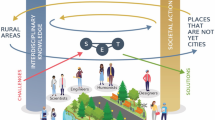Abstract
In this paper, I develop an optimization model for integrated urban planning for land use at the municipality level, in which decisions arise from an area-based weighted-GDP maximisation algorithm whose weights represent the sustainability and implementability of the land uses. The model favours the involvement of stakeholders in urban governance, but does not use complicated assessment procedures for non-economic indicators or relative weights to combine economic, social and environmental indicators; instead, the integration between economic activities and environmental status is represented objectively and non-linearly by referring to initial and sustainability conditions. The model accounts for both human and environmental dynamics by adopting a spatial structure that permits compromises between economic information (available at a macro level) and ecological information (available at a micro level). A single value is attached to each urban governance, with an elicitation of future decisions (including acceptance of the status quo) and the ability to provide an evaluation of past decisions: some environmental policies are considered. The model’s predictions are based on reasonably reliable knowledge that can be easily collected, with reliability determined by calculating the confidence level. The resulting urban governance can then be presented and further analysed within a geographical information system. A case study of the model’s application to Algeria’s Reghaïa and Heraoua municipalities provides insights into optimal urban governance, with and without water quantity or quality policies, in terms of resource sustainability, sectoral development, and pollution sustainability. I also assess the previous master plan in terms of the land uses suggested by the model.







Similar content being viewed by others
References
Alig RJ et al (2004) Urbanisation on the US landscape: looking ahead in the 21st century. Landscape and Urban Planning 69:219–234
Apolloni B et al (2006) Algorithmic inference in machine learning. Advanced Knowledge International, Adelaide
Awad AR, Aboul-Ela MT (2003) Urban planning for low-income groups with developed optimization models. Advanced Engineering Software 34:607–619
Baban SMJ et al (2008) Managing development in the hillsides of Trinidad and Tobago using geo-informatics. Sustainable Development 16:314–328
Barton H (2009) Land use planning and health and well-being. Land Use Policy 26S:S115–S123
Begum A (2007) Urban housing as an issue of redistribution through planning? The case of Dhaka city. Social Policy and Administration 41:410–418
Berling-Wolff S, Wu J (2004) Modelling urban landscape dynamics: a case study in Phoenix, USA. Urban Ecosystems 7:215–240
Borrego C et al (2006) How urban structure can affect city sustainability from an air quality perspective. Environmental Modelling and Software 21:461–467
Campbell HF, Brown RPC (2005) A multiple account framework for cost-benefit analysis. Evaluation and Program Planning 28:23–32
De Almeida CM et al (2003) Stochastic cellular automata modelling of urban land use dynamics: empirical development and estimation, Computers. Environment and Urban Systems 27:481–509
DGE (2001) Communication nationale initiale. Direction des Grandes Entreprises, Alger
Gabriel SA et al (2006) A multi-objective optimization approach to smart growth in land development. Socio-Economic Planning Sciences 40:212–248
Gao J et al (2007) An assessment of flood hazard vulnerability in the Dongting Lake Region of China. Lakes and Reservoirs: Research and Management 12:27–34
Kattwinkel M et al (2009) Modelling multi-species response to landscape dynamics: mosaic cycles support urban biodiversity. Landscape Ecology 24:929–941
King P et al (2003) Integrated economic and environmental planning in Asia: a review of progress and proposals for policy reform. Progress in Planning 59:233–315
Kong F et al (2010) Urban green space network development for biodiversity conservation: identification based on graph theory and gravity modelling. Landscape and Urban Planning 95(1–2):16–27
Lin Y-P et al (2009) Developing and comparing optimal and empirical land-use models for the development of an urbanized watershed forest in Taiwan. Landscape and Urban Planning 92:242–254
Meyer BC et al (2009) Comparison of two spatial optimization techniques: a framework to solve multi-objective land use distribution problems. Environmental Management 43:264–281
Murray AT (2010) Advances in location modelling: GIS linkages and contributions. Journal of Geographical Systems 12:335–354
PAC (2004a) Gestion intégrée des ressources en eau et assainissement liquide. Programme d’Amenagement Cotier, Alger
PAC (2004b) Maitrise de l’urbanisation et de l’artificialisation des sols. Programme d’Amenagement Cotier, Alger
PAC (2004c) Étude prospective de l’urbanisation. Programme d’Amenagement Cotier, Alger
PAC (2005a) Action pilote: site du lac de Reghaïa. Programme d’Amenagement Cotier, Alger
PAC (2005b) Le coût de la dégradation de l’environnement cotier en Algérie. Programme d’Amenagement Cotier, Alger
PAC (2005c) Impacts des activités anthropiques. Programme d’Amenagement Cotier, Alger
PAC (2006) Rapport finale intégrée. Programme d’Amenagement Cotier, Alger
Pauleit S, Duhme F (2000) Assessing the environmental performance of land cover types for urban planning. Landscape and Urban Planning 52:1–20
Prato T (2007) Evaluating LU plans under uncertainty. Land Use Policy 24:165–174
Rebelo EM (2009) Land economic rent computation for urban planning and fiscal purposes. Land Use Policy 26:521–534
Silva EA et al (2008) Strategies for landscape ecology: an application using CA models. Progress in Planning 70:133–177
Stevens D et al (2007) iCity: a GIS-CA modelling tool for urban planning and decision making. Environmental Modelling and Software 22:761–773
UN-Habitat (2009a) Planning sustainable cities: policy directions. Earthscan, London
UN-Habitat (2009b) Global report on human settlements 2009: planning sustainable cities. Earthscan, London
Wang X et al (2004) Land allocation based on integrated GIS-optimization modelling at a watershed level. Landscape and Urban Planning 66:61–74
Acknowledgments
The support of the European Commission (SMAP III Programme) is gratefully acknowledged, while Elena Fabbri and Elisa Ulazzi, Manager and Coordinator of the Algerian Coast Management through Integration and Sustainability (AMIS) project, are sincerely thanked for their patient work.
Author information
Authors and Affiliations
Corresponding author
Rights and permissions
About this article
Cite this article
Zagonari, F. An Optimization Model for Integrated Urban Planning: Development and Application to Algeria’s Reghaïa and Heraoua Municipalities. Environmental Management 47, 937–959 (2011). https://doi.org/10.1007/s00267-011-9666-8
Received:
Accepted:
Published:
Issue Date:
DOI: https://doi.org/10.1007/s00267-011-9666-8




